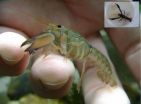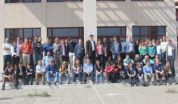(Press-News.org) European scientists have made ground-breaking discoveries for improving the efficiency of the production of pharmaceuticals through plant biotechnology. Biotechnological production offers a cost-effective and environmentally friendly alternative to the chemical synthesis of rare and complex pharmaceutical compounds currently isolated from plants. The results have been achieved in the European SmartCell project coordinated by VTT Technical Research Centre of Finland.
Several expensive anticancer alkaloid blockbusters used in chemotherapy, such as terpenoid indole alkaloids - vinblastine and vincristine, are currently extracted from the plant Catharanthus roseus (Madagascar periwinkle) at high price. These compounds are used to treat Hodgkin's lymphoma, breast cancer, small-cell lung cancer and leukemia. Typically, very low levels accumulate in plant tissues, but chemical synthesis is not an economical alternative either due to their highly complex structures and specific stereochemical features. Internationally, much effort has been invested to develop more accessible and cost-effective sources of these drugs.
The biotechnological production of high-value plant-derived compounds using plant cell cultures is an attractive and sustainable alternative to extraction from whole plant material. However, the biosynthetic pathway leading to these compounds in plants is long and complex, with multiple enzymatic steps that are still largely uncharacterized at the genetic level. One of the main goals of the European Consortium SmartCell was to unravel the metabolic pathway leading to the periwinkle terpenoid indole alkaloids.
The SmartCell Consortium succeeded in elucidating the complete upstream segment of the terpenoid indole alkaloid biosynthesis pathway, as described in a ground-breaking article published in the journal Nature Communications (Publication date: April 7th, 2014).
The complete pathway of twelve enzymes was reconstructed in tobacco plants, paving the way for cost-effective production of diverse therapeutic compounds. Moreover, cell culture technologies were developed, and the cultivation of the plant cells was scaled-up using bioreactors at VTT's pilot laboratory in Finland.
"The use of plant cells as real green chemical factories is now becoming feasible for the first time. The technology developed and the experience gained on terpenoid indole alkaloids in this project can be utilized and applied to other compounds and plants as well", says the project coordinator Dr Kirsi-Marja Oksman-Caldentey from VTT.
INFORMATION:
SmartCell project
SmartCell was a four-year FP7 framework project, funded by the European Commission with a total budget of 8.5 million euros.
The Consortium was coordinated by Dr Kirsi-Marja Oksman-Caldentey at VTT. It comprised 14 academic partners from leading European universities and research institutes, and four industrial members.
The SmartCell project aimed at developing comprehensive knowledge and enabling technologies to control and engineer plants and plant cells for the rational production of high-value plant-derived compounds for industrial use.
The findings of the SmartCell project have thus far resulted in a total of 118 peer-reviewed scientific publications.
Further information
VTT Technical Research Centre of Finland
Dr Kirsi-Marja Oksman-Caldentey, Head of Industrial Biotechnology
Tel. +358 20 722 4459, kirsi-marja.oksman@vtt.fi
The European Consortium SmartCell: http://www.smart-cell.org
Publication
K. Miettinen, L. Dong, N. Navrot, T. Schneider, V. Burlat, J. Pollier, L. Woittiez, S. van der Krol, R. Lugan, T. Ilc, R. Verpoorte, K.-M. Oksman-Caldentey, E. Martinoia, H.J. Bouwmeester, A. Goossens, J. Memelink & D. Werck-Reichhart (2014): The seco-iridoid pathway from Catharanthus roseus. Nature Communications. Publication date: April 7th, 2014.
Media material
Photo: The main source of vinblastine and vincristine is the Madagascar periwinkle (Catharanthus roseus), also known as an ornamental plant. The SmartCell Consortium succeeded in elucidating the complete upstream segment of the biosynthetic pathway leading to these valuable anticancer pharmaceuticals, and thus creating the basis for their biotechnological production. (Photo: VTT)
Further information on VTT:
Olli Ernvall
Senior Vice President, Communications
358 20 722 6747
olli.ernvall@vtt.fi
http://www.vtt.fi
VTT Technical Research Centre of Finland
VTT is a leading multitechnological applied research organization in Northern Europe. VTT creates new technology and science-based innovations in co-operation with domestic and foreign partners. Every third Finnish technology innovation contains VTT expertise. VTT's turnover is EUR 310 million and its personnel totals 2,900.
Novel plant biotechnology approach for sustainable production of pharmaceutical compounds
2014-04-08
ELSE PRESS RELEASES FROM THIS DATE:
New breast cancer results illustrate promise and potential of I-SPY 2 trial
2014-04-08
In an innovative clinical trial led by UC San Francisco, the experimental drug neratinib along with standard chemotherapy was found to be a beneficial treatment for some women with newly diagnosed, high-risk breast cancer.
Additionally, researchers learned that an algorithm used in the adaptive, randomized trial known as I-SPY 2 was highly effective at predicting the success of the treatment regimen in the patients who have HER2-positive/HR-negative disease.
The finding marks the second drug "graduation" within the I-SPY 2 trial model, which is designed to accelerate ...
Geography research could improve the effectiveness of hospital patient transport services
2014-04-08
University of Cincinnati research is offering hospitals and trauma centers a unique, accurate and scientific approach to making decisions about transporting critical-care patients by air or by ambulance. A presentation this week at the annual meeting of the Association of American Geographers (AAG) in Tampa, Fla., highlights the research of Michael Widener, a UC assistant professor of geography, along with Zac Ginsberg, MD, Maryland Shock Trauma Center; Samuel Galvagno Jr., assistant professor, Divisions of Trauma Anesthesiology and Adult Critical Care Medicine, Maryland ...
Grandmas stay sharp when they care for grandkids once a week
2014-04-08
CLEVELAND, Ohio (April 8, 2014)—Taking care of grandkids one day a week helps keep grandmothers mentally sharp, finds a study from the Women's Healthy Aging Project study in Australia, published online today in Menopause, the journal of The North American Menopause Society (NAMS). That's good news for women after menopause, when women need to lower their risks of developing Alzheimer's disease and other cognitive disorders.
On the other hand, taking care of grandchildren five days a week or more had some negative effects on tests of mental sharpness. "We know that older ...
Graphic photos on tobacco packs save lives: WHO report
2014-04-08
BEIJING, 8 April 2014 – Large, graphic health warnings on tobacco packets in China would increase awareness about the harms of smoking, help to cut smoking rates, and in doing so save lives according to global studies. These are the key findings from a new report, Tobacco health warnings in China – Evidence of effectiveness and implications for action, from the World Health Organization (WHO) and the International Tobacco Control Policy Evaluation Project (ITC Project), released today.
"This new report presents a very compelling case for the introduction of large, pictorial ...
A new tiny species of crayfish from the swamps of coastal eastern Australia
2014-04-08
Hidden in one of Australia's most developed and fastest growing areas lives one of the world's smallest freshwater crayfish species. Robert B McCormack the Team Leader for the Australian Crayfish Project described the new species belonging to the genus Gramastacus, after 8 years of research in the swamps and creeks of coastal New South Wales, Australia. The study was published in the open access journal ZooKeys.
Being a small crayfish species it has remained undescribed and undiscovered in one of the fastest developing regions of Australia. Only one other species of Gramastacus ...
Common diabetes treatment could extend hypoglycemia
2014-04-08
Researchers at the University of Adelaide have discovered that a common treatment for people with type 2 diabetes could cause longer-than-normal periods of the low blood sugar reaction hypoglycemia, which may result in increased health risks to people with diabetes.
The treatment is the use of the peptide GLP-1 (glucagon-like peptide 1) in combination with insulin, which is now used throughout the world as a standard therapy for patients with type 2 diabetes.
A team of researchers at the University of Adelaide's School of Medicine has investigated the impact of this ...
Good provider communication improves antidepressant adherence for diabetes patients
2014-04-08
OAKLAND, Calif., April 8, 2014 — Adult patients with diabetes who trust their medical provider and feel included in treatment decisions are significantly more likely to take and maintain a newly prescribed antidepressant medication, according to a new study in the Journal of General Internal Medicine.
The study, conducted by researchers at the Kaiser Permanente Division of Research and the University of Washington, School of Medicine, included 1,500 patients with long-standing diabetes, who were prescribed antidepressants.
"In patients with diabetes, depression has ...
Researchers measure smartphone malware infection rates
2014-04-08
There is a steady stream of news stories and announcements about how many more new strains of Android malware appear in every passing year. Data showing infection rates in the real world has been hard to come by. There is a lot of data about the number of different malware samples discovered but not so much about the extent they are actually found in the wild. If smartphones are infected to the same extent as personal computers used to be, the resulting damage would be much more severe.
The few estimates that were out there vary greatly: ranging from more than 4 per ...
Scientists disagree on responsible research
2014-04-08
"We have, on the one hand, scientists who are convinced that they should be left alone in their ivory tower and that neither politicians nor the general public should interfere with their research activities. In their eyes, the key to conducting responsible science is to protect it from external interest because that will introduce harmful biases. Science should therefore be completely independent and self-regulated in order to be responsible," says communication researcher Maja Horst from the University of Copenhagen. She continues:
"But, on the other hand, there are ...
Improved access to integrated biodiversity data for science, practice, and policy
2014-04-08
The world's biodiversity is in an ongoing dramatic decline that despite conservation efforts remains unprecedented in its speed and predicted effects on global ecosystem functioning and services. The lack of available integrated biodiversity information for decisions in sectors other than nature conservation has been recognized as a main obstacle and the need to provide readily accessible data to support political decisions has been integrated into the CBD's "Strategic Plan for Biodiversity 2011–2020" and the Aichi targets.
A review paper recently published in the open ...


